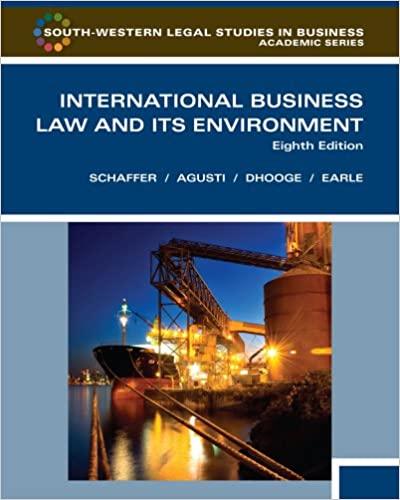Question
1. The written guidelines issued by an organization to its workers and management, to help them conduct their actions in accordance with its primary values
1. The written guidelines issued by an organization to its workers and management, to help them conduct their actions in accordance with its primary values and ethical standards is known as;
a.
Ethics
b.
Methods
c.
Instruction
d.
Labour law
2. A snapshot of historical overview of labour law suggests that labour unrest was common in ocean industry during the last quarter of 18th & 19th century - US/Britain context.
a.
True
b.
False
3. Railway Labour Act (1923) was introduced with the objective to promote for the freedom of association of employees (the right join a labour union)
a.
False
b.
True
4. A snapshot of Fiji's labour law suggests that Fiji ratified convention 98 [1949] "Right to organise" and convention 97 [1948] "Freedom of Association" in 1996.
a.
True
b.
False
5. The body of law that governs the employer-employee relationship, including individual employment contracts, the application of tort and contract doctrines, and a large group of statutory regulations on issues such as the right to organize and negotiate collective bargaining agreements, protection from discrimination, wages and hours, and health and safety is known as:
a.
Ethics
b.
Methods
c.
Instruction
d.
Labour law
6. The law established by following earlier judicial decision rather than statutes or constitution. Often, it is called Judge made laws is known as;
a.
Common law
b.
Legislation
c.
Code of practice
d.
Criminal law
7. The code of ethics, code of good faith bargaining standard policies & procedures on confidentiality, record keeping are example of:
a.
Common law
b.
Administrative practices
c.
Legislation
d.
Code of practice
8. Which of the following is NOT a voluntary source of labour law;
a.
Work rules
b.
Workforce agreements
c.
Code of practice
d.
Collective agreements
9. The agreement that determines the relationship between an employer & a union which represents its members is known as:
a.
Collective agreements
b.
Code of practice
c.
Work rules
d.
Workforce agreements
10. The body of law that relates to crime. It regulates social conduct and proscribes threatening, harming, or otherwise endangering the health, safety, and moral welfare of people. This law is known as:
a.
Common law
b.
Legislation
c.
Criminal law
d.
Code of practice
11. It's against the law for employers to discriminate against you because of your race, disability, colour, age, sexual orientation, gender, language, economic status, language.
a.
False
b.
True
12. Employers who practise equality do not have access to a larger and more diverse workforce.
a.
True
b.
False
13. ILO standards on equality provide tools to eliminate discrimination in all aspects of the workplace and in society as a whole.
a.
False
b.
True
14. According to the constitution of Fiji, workers have the right to form and join employer's association, and employers have the right to form and join trade union organisations.
a.
True
b.
False
15. Workers and employers have the right to organise and bargain collectively.
a.
True
b.
False
16. A legally enforceable agreement between two or more parties with mutual obligations is known as:
a.
Work rules
b.
Workforce agreement
c.
Code of practise
d.
Contract
17. The manifestation of the "willingness to enter into a bargain so made as to justify another person in understanding that his assent to the bargain is invited and will conclude it is known as:
a.
An offer
b.
Contract
c.
An acceptance
d.
Proposed contract
18. The meeting of the minds that refers to the parties' mutual understanding and assent to the expression of their agreement is known as;
a.
Mutuality of obligation
b.
Consideration
c.
Manifestation
d.
Cognitive manifestation
19. Terms that imply certain responsibilities and duties into the contract of employment, unless the parties agree otherwise. For examples: employee must not damage company assets, behave responsibly, honesty, etc. This is known as:
a.
Written terms
b.
Expressed Terms
c.
Implied terms
d.
Verbal terms
20. The type of employment contract where employees work fewer hours than full time employees, but unlike casual employees, are employed on permanent basis is known as:
a.
Part time employees
b.
Permanent employees
c.
Full time employees
d.
Casual employees
Step by Step Solution
There are 3 Steps involved in it
Step: 1

Get Instant Access to Expert-Tailored Solutions
See step-by-step solutions with expert insights and AI powered tools for academic success
Step: 2

Step: 3

Ace Your Homework with AI
Get the answers you need in no time with our AI-driven, step-by-step assistance
Get Started


